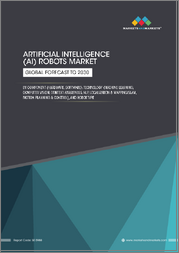
|
시장보고서
상품코드
1681604
로보틱스 시장 규모, 점유율, 성장 분석 : 컴포넌트별, 유형별, 환경별, 모빌리티별, 용도별, 최종사용자별, 지역별 - 산업 예측(2025-2032년)Robotics Market Size, Share, and Growth Analysis, By Component, By Type (Autonomous Mobile Robots, Automated Guided Vehicles ), By Environment, By Mobility, By Application, By End User, By Region - Industry Forecast 2025-2032 |
||||||
세계의 로보틱스 시장 규모는 2023년에 398억 달러로 평가되며, 예측 기간(2025-2032년)의 CAGR은 17.0%로, 2024년 465억 7,000만 달러에서 2032년에는 1,635억 1,000만 달러로 성장할 전망입니다.
서비스 로봇 시장은 특히 의료 분야에서 크게 성장하고 있으며, 로봇 공학이 수술의 정확성과 효율성을 높이고 있습니다. 이러한 추세는 자동차 및 제조업을 포함한 다양한 산업에서 생산 및 유지보수를 간소화하는 자율 로봇의 혁신으로 더욱 증폭되고 있습니다. 생산성 향상, 인건비 절감, 산업재해 감소가 시장 확대의 주요 요인으로 작용하고 있습니다. 급속한 기술 발전과 산업 자동화에 대한 투자 증가도 이러한 수요 급증에 기여하고 있습니다. 그러나 시장 경쟁과 신규 진입으로 인해 시장은 여전히 불안정한 상태를 유지하고 있습니다. 클라우드 연결을 통해 업무 효율성을 개선하도록 설계된 스마트 협동 로봇과 AI 통합 시스템의 등장은 다양한 부문의 자동화 성장에 좋은 징조를 보이고 있습니다.
목차
서론
- 조사의 목적
- 조사 범위
- 정의
조사 방법
- 정보 조달
- 2차와 1차 데이터 방법
- 시장 규모 예측
- 시장의 전제조건과 제한
개요
- 세계 시장 전망
- 공급과 수요 동향 분석
- 부문별 기회 분석
시장 역학과 전망
- 시장 개요
- 시장 규모
- 시장 역학
- 촉진요인과 기회
- 억제요인과 과제
- Porter의 산업 분석
주요 시장 인사이트
- 주요 성공 요인
- 경쟁의 정도
- 주요 투자 기회
- 시장 에코시스템
- 시장의 매력 지수(2024년)
- PESTEL 분석
- 거시경제 지표
- 밸류체인 분석
- 가격 분석
로보틱스 시장 규모 : 컴포넌트별
- 시장 개요
- 하드웨어
- 센서
- 액추에이터
- 전원
- 제어 시스템
- 소프트웨어
- 서비스
로보틱스 시장 규모 : 유형별
- 시장 개요
- 자율 이동 로봇(AMR)
- 무인운반차(AGV)
- 다관절로봇
- 휴머노이드
- 협동 로봇(코봇)
- 기타
로보틱스 시장 규모 : 환경별
- 시장 개요
- 항공
- 지상
- 해양
로보틱스 시장 규모 : 모빌리티별
- 시장 개요
- 모바일 로보틱스
- 고정형 로보틱스
로보틱스 시장 규모 : 용도별
- 시장 개요
- 자재관리
- 조립과 분해
- 용접과 솔더링
- 조제와 처리
- 보안과 검사
- 청소와 소독
- 퍼스널 어시스턴스
- 기타
로보틱스 시장 규모 : 최종사용자별
- 시장 개요
- 가정/세대
- 바닥 청소
- 잔디 청소
- 풀 청소
- 창문 청소
- 기타
- 산업
- 자동차
- 전기·전자
- 식품 및 음료
- 의약품 및 바이오테크놀러지
- 화장품
- 유제품
- 금속·기계
- 플라스틱 고무 화학제품
- 기타
- 의료·헬스케어
- 농업과 농업
- 소매업과 접객(Hoapitality)
- 물류·창고
- 군·방위
- 건설·인프라
- 해양
- 교육
- 스포츠와 엔터테인먼트
- 기타
로보틱스 시장 규모
- 북미
- 미국
- 캐나다
- 유럽
- 독일
- 스페인
- 프랑스
- 영국
- 이탈리아
- 기타 유럽 지역
- 아시아태평양
- 중국
- 인도
- 일본
- 한국
- 기타 아시아태평양
- 라틴아메리카
- 브라질
- 기타 라틴아메리카 지역
- 중동 및 아프리카
- GCC 국가
- 남아프리카공화국
- 기타 중동 및 아프리카
경쟁 정보
- 상위 5사의 비교
- 주요 기업의 시장 포지셔닝(2024년)
- 주요 시장 기업이 채택한 전략
- 최근 시장 동향
- 기업의 시장 점유율 분석(2024년)
- 주요 기업의 기업 개요
- 기업의 상세
- 제품 포트폴리오 분석
- 기업의 부문별 점유율 분석
- 매출의 전년대비 비교(2022-2024년)
주요 기업 개요
- ABB(Switzerland)
- FANUC Corporation(Japan)
- Yaskawa Electric Corporation(Japan)
- Omron Corporation(Japan)
- Boston Dynamics(USA)
- Intuitive Surgical, Inc.(USA)
- Teradyne, Inc.(USA)
- L3Harris Technologies, Inc.(USA)
- Lockheed Martin Corporation(USA)
- Northrop Grumman Corporation(USA)
- Raytheon Technologies Corporation(USA)
- Siemens AG(Germany)
- Hyundai Robotics(South Korea)
- Denso Corporation(Japan)
- Amazon Robotics(USA)
- Cognex Corporation(USA)
결론과 제안
KSA 25.04.29Global Robotics Market size was valued at USD 39.8 billion in 2023 and is poised to grow from USD 46.57 billion in 2024 to USD 163.51 billion by 2032, growing at a CAGR of 17.0% during the forecast period (2025-2032).
The service robot market is experiencing significant growth, particularly in the medical sector, as robotics enhance surgical precision and efficiency. This trend is further amplified by innovations in autonomous robots, which streamline production and maintenance across various industries, including automotive and manufacturing. The increased productivity, reduced labor costs, and decrease in workplace accidents are key drivers of market expansion. Rapid technological advancements and rising investments in industrial automation are also contributing to this surge in demand. However, the market remains volatile due to competitive dynamics and the entry of new players. The rise of smart collaborative robots and AI-integrated systems, designed to improve operational efficiency through cloud connectivity, bodes well for future growth in automation across diverse sectors.
Top-down and bottom-up approaches were used to estimate and validate the size of the Global Robotics market and to estimate the size of various other dependent submarkets. The research methodology used to estimate the market size includes the following details: The key players in the market were identified through secondary research, and their market shares in the respective regions were determined through primary and secondary research. This entire procedure includes the study of the annual and financial reports of the top market players and extensive interviews for key insights from industry leaders such as CEOs, VPs, directors, and marketing executives. All percentage shares split, and breakdowns were determined using secondary sources and verified through Primary sources. All possible parameters that affect the markets covered in this research study have been accounted for, viewed in extensive detail, verified through primary research, and analyzed to get the final quantitative and qualitative data.
Global Robotics Market Segments Analysis
Global Robotics Market is segmented by Component, Type, Environment, Mobility, Application, End User and region. Based on Component, the market is segmented into Hardware, Software and Services. Based on Type, the market is segmented into Autonomous Mobile Robots (AMRs), Automated Guided Vehicles (AGVs), Articulated Robots, Humanoids, Collaborative Robots (Cobots) and Others. Based on Environment, the market is segmented into Aerial, Ground and Marine. Based on Mobility, the market is segmented into Mobile Robotics and Fixed Robotics. Based on Application, the market is segmented into Material Handling, Assembling & Disassembling, Welding & Soldering, Dispensing & Processing, Security & Inspection, Cleaning & Sanitization, Personal Assistance and Others. Based on End User, the market is segmented into Domestic/Household, Industrial, Medical & Healthcare, Farming and Agriculture, Retail and Hospitality, Logistics & Warehousing, Military & Defense, Construction & Infrastructure, Marine, Education, Sports & Entertainment and Others. Based on region, the market is segmented into North America, Europe, Asia Pacific, Latin America and Middle East & Africa.
Driver of the Global Robotics Market
The Global Robotics market is driven by the increasing adaptation of robotic technologies to non-industrial applications, particularly in sectors like healthcare and agriculture. The healthcare industry is poised for significant growth, with robots already facilitating minimally invasive surgeries in areas such as urology and gynecology, and they are expected to be integrated into more complex medical procedures in the future. Similarly, agriculture is witnessing a rise in robotic utilization due to labor shortages and escalating costs. Advanced robotic harvesters can efficiently pick fruits and vegetables without damage, employing sophisticated graphic processing units to assess ripeness. As developers focus on creating application-specific robots, the expansion of automated technology beyond traditional industrial uses is propelling the market's substantial growth.
Restraints in the Global Robotics Market
The Global Robotics market may face significant restraints due to growing ethical concerns regarding data ownership, especially with the increasing prevalence of software services integrated into robotic systems. The potential for robots to collect and mishandle sensitive information raises apprehensions about data breaches, which can have severe consequences in critical sectors such as military, defense, and healthcare. Consequently, the emphasis on data security and privacy is becoming increasingly crucial, and if these concerns are not adequately addressed, they could pose a formidable barrier to the growth and expansion of the robotics industry in the foreseeable future.
Market Trends of the Global Robotics Market
The Global Robotics market is witnessing a significant trend towards service-enabled robotics, spurred by the increasing demand for efficiency and quality in various sectors. As businesses seek to automate repetitive and ergonomically challenging tasks, robots are becoming integral in enhancing information sharing and operational effectiveness. Retailers are particularly leveraging in-store robots for real-time behavior analysis and error reduction, while the popularity of lightweight smart robotic vacuum cleaners is surging due to their versatility in sanitation and maintenance. The COVID-19 pandemic has further accelerated this trend, fostering a heightened awareness of health and cleanliness, which drives demand for intelligent robotic solutions to ensure safe environments.
Table of Contents
Introduction
- Objectives of the Study
- Scope of the Report
- Definitions
Research Methodology
- Information Procurement
- Secondary & Primary Data Methods
- Market Size Estimation
- Market Assumptions & Limitations
Executive Summary
- Global Market Outlook
- Supply & Demand Trend Analysis
- Segmental Opportunity Analysis
Market Dynamics & Outlook
- Market Overview
- Market Size
- Market Dynamics
- Drivers & Opportunities
- Restraints & Challenges
- Porters Analysis
- Competitive rivalry
- Threat of substitute
- Bargaining power of buyers
- Threat of new entrants
- Bargaining power of suppliers
Key Market Insights
- Key Success Factors
- Degree of Competition
- Top Investment Pockets
- Market Ecosystem
- Market Attractiveness Index, 2024
- PESTEL Analysis
- Macro-Economic Indicators
- Value Chain Analysis
- Pricing Analysis
Global Robotics Market Size by Component & CAGR (2025-2032)
- Market Overview
- Hardware
- Sensor
- Actuator
- Power Source
- Control System
- Software
- Services
Global Robotics Market Size by Type & CAGR (2025-2032)
- Market Overview
- Autonomous Mobile Robots (AMRs)
- Automated Guided Vehicles (AGVs)
- Articulated Robots
- Humanoids
- Collaborative Robots (Cobots)
- Others
Global Robotics Market Size by Environment & CAGR (2025-2032)
- Market Overview
- Aerial
- Ground
- Marine
Global Robotics Market Size by Mobility & CAGR (2025-2032)
- Market Overview
- Mobile Robotics
- Fixed Robotics
Global Robotics Market Size by Application & CAGR (2025-2032)
- Market Overview
- Material Handling
- Assembling & Disassembling
- Welding & Soldering
- Dispensing & Processing
- Security & Inspection
- Cleaning & Sanitization
- Personal Assistance
- Others
Global Robotics Market Size by End User & CAGR (2025-2032)
- Market Overview
- Domestic/Household
- Floor Cleaning
- Lawn Cleaning
- Pool Cleaning
- Window Cleaning
- Others
- Industrial
- Automotive
- Electrical & Electronics
- Food & Beverages
- Pharmaceuticals and Biotech
- Cosmetics
- Dairy
- Metals & Machinery
- Plastics, Rubbers, & Chemicals
- Others
- Medical & Healthcare
- Farming and Agriculture
- Retail and Hospitality
- Logistics & Warehousing
- Military & Defense
- Construction & Infrastructure
- Marine
- Education
- Sports & Entertainment
- Others
Global Robotics Market Size & CAGR (2025-2032)
- North America (Component, Type, Environment, Mobility, Application, End User)
- US
- Canada
- Europe (Component, Type, Environment, Mobility, Application, End User)
- Germany
- Spain
- France
- UK
- Italy
- Rest of Europe
- Asia Pacific (Component, Type, Environment, Mobility, Application, End User)
- China
- India
- Japan
- South Korea
- Rest of Asia-Pacific
- Latin America (Component, Type, Environment, Mobility, Application, End User)
- Brazil
- Rest of Latin America
- Middle East & Africa (Component, Type, Environment, Mobility, Application, End User)
- GCC Countries
- South Africa
- Rest of Middle East & Africa
Competitive Intelligence
- Top 5 Player Comparison
- Market Positioning of Key Players, 2024
- Strategies Adopted by Key Market Players
- Recent Developments in the Market
- Company Market Share Analysis, 2024
- Company Profiles of All Key Players
- Company Details
- Product Portfolio Analysis
- Company's Segmental Share Analysis
- Revenue Y-O-Y Comparison (2022-2024)
Key Company Profiles
- ABB (Switzerland)
- Company Overview
- Business Segment Overview
- Financial Updates
- Key Developments
- FANUC Corporation (Japan)
- Company Overview
- Business Segment Overview
- Financial Updates
- Key Developments
- Yaskawa Electric Corporation (Japan)
- Company Overview
- Business Segment Overview
- Financial Updates
- Key Developments
- Omron Corporation (Japan)
- Company Overview
- Business Segment Overview
- Financial Updates
- Key Developments
- Boston Dynamics (USA)
- Company Overview
- Business Segment Overview
- Financial Updates
- Key Developments
- Intuitive Surgical, Inc. (USA)
- Company Overview
- Business Segment Overview
- Financial Updates
- Key Developments
- Teradyne, Inc. (USA)
- Company Overview
- Business Segment Overview
- Financial Updates
- Key Developments
- L3Harris Technologies, Inc. (USA)
- Company Overview
- Business Segment Overview
- Financial Updates
- Key Developments
- Lockheed Martin Corporation (USA)
- Company Overview
- Business Segment Overview
- Financial Updates
- Key Developments
- Northrop Grumman Corporation (USA)
- Company Overview
- Business Segment Overview
- Financial Updates
- Key Developments
- Raytheon Technologies Corporation (USA)
- Company Overview
- Business Segment Overview
- Financial Updates
- Key Developments
- Siemens AG (Germany)
- Company Overview
- Business Segment Overview
- Financial Updates
- Key Developments
- Hyundai Robotics (South Korea)
- Company Overview
- Business Segment Overview
- Financial Updates
- Key Developments
- Denso Corporation (Japan)
- Company Overview
- Business Segment Overview
- Financial Updates
- Key Developments
- Amazon Robotics (USA)
- Company Overview
- Business Segment Overview
- Financial Updates
- Key Developments
- Cognex Corporation (USA)
- Company Overview
- Business Segment Overview
- Financial Updates
- Key Developments



















